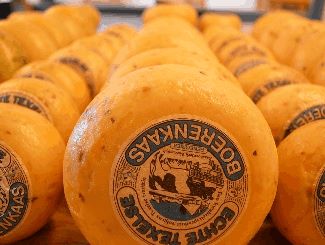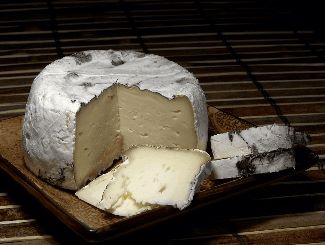|
Topping this month's article off with a slice of cheese.
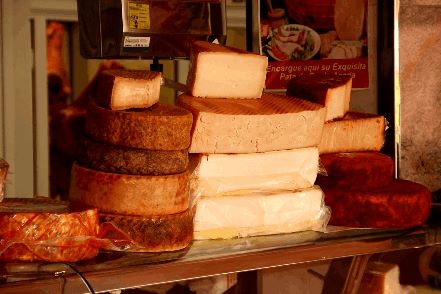 A counter of a cheese market with several types of cheese on display. So far, we have discussed some basic foods that are common to most cultures: sausage, bread, and milk. This time we are looking at another one, cheese, which has the distinctive feature of being not only a basic food, but also one which we add to other foods.
For example, what do you add to your pasta dish to make it tastier? Some grated cheese, of course. What do you add to your hamburgers and other sandwiches for more flavour? Cheese again! And when you are enjoying a snack in the afternoon of wine and crackers, what tops it all off? Cheese!
While cheese is quite appealing to our palates, the description of how it is made may not be. The Encyclopedia Britannica describes it as:
"When milk sours, it forms both a protein-rich gel, or curd, and a lactose-rich fluid, or whey. Coagulation is often facilitated by adding rennin, an enzyme that acts on the milk's chief protein, casein. The resulting curd is then cut or broken to release most of the whey. Ripening and curing are affected by moisture content, acidity, presence of micro-organisms, and other factors. Products vary according to fat content of the milk, heating or pasteurization, and addition of enzymes or cultures of bacteria, molds, or yeasts."
See? Bacteria in coagulated sour milk. Yum! Just be glad I never went into the details about how sausages are made.
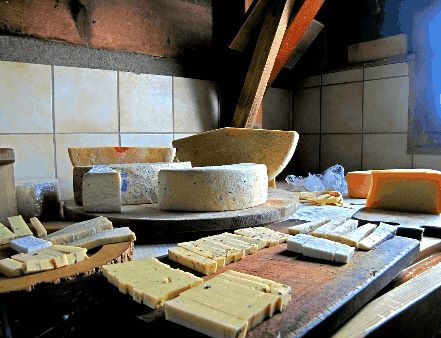 An old fashioned cheese shop showing cheese sliced into smaller sticks. The etymology for cheese is rather odd. Normally, we have found a clear-cut division of where the words originated from, with the Italic language words coming from Latin and Germanic words coming from Latin or Old English. This time, however, it seems to be a jumble of borrowing and changing the words in a seemingly random order.
The basic English "cheese" is taken from the Old West Germanic "kasjus," which in turn got it from the Latin "caseus." The Latin was probably obtained from the Proto-Indo-European [PIE] "kwat," meaning "to ferment, become sour." You can see how the other West Germanic languages are similar: Dutch (kaas), German (Käse), and Yiddish (kez). The Latin root also provides the Spanish (queso) and Portuguese (queijo).
Now, this is where it gets odd, as I mentioned. The Italian and French dialects do NOT take their words directly from the Latin root, as did the Spanish, but instead seem to take it from a Latin phrase "formaticus caseus" or "shaped cheese." Latin "formaticum" means "shape," so by a meaning transfer from cheese to the definition of it, the French got "formage," which later became "fromage." From this, other Italic languages got their words: Italian (formaggio), Catalan (formatge), and Wallon (froumadje). While these cover most of the Italic languages' words, Romanian's "brânză" is still a mystery.
While the Latin "caseus" may have come from the Proto-Indo-European word meaning "to become sour," there was another PIE word for simply "sour," which was "syr" or "sir," referring to the milk used in the making of the cheese. This was adopted by the Slavic languages as their base: Polish (ser), Russian (сыр [syr]), Serbian (сир [sir]), Slovenian (sir). It seems the Baltic languages also took their words from this base: Latvian (siers), Lithuanian (sūris), Sudovian (sūris), and Prussian (suris).
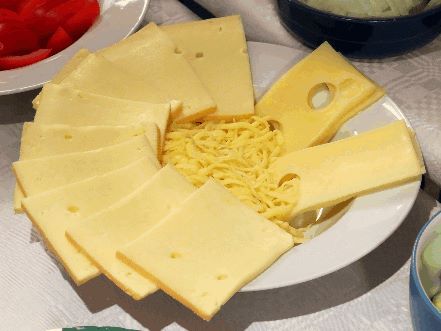 A plate of cheeses: Raclette, Gouda, and Emmental. Now, this is largely a guess on my part, but it would appear that the Northern Germanic languages also adopted the "syr/sir" base, with their own adaptation. First, a "t" was added, giving a more palatalised sound. I am not familiar enough with linguistical transformations to explain the attaching of the "o", however. If this is what happened, it would explain the North Germanic words like Danish (ost) and Faeroese (ostur).
Japanese "チーズ" [CHIIZU] comes directly from the English "cheese," as the Korean "치즈" [chijeu] is also likely to be. The Japanese also have another word, "乾酪 [kanraku]," but I am told it's not commonly used in the modern language. The first character, 乾, means 'dry,' 'cured,' and the second character, 酪, means 'dairy product," 'whey.'
Cheese Types
For most of the varieties, the names of cheeses stem from where they are made. Roquefort is from a village in the southwest of France. Stilton and Cheddar are from places in England. Parmesan, Romano, and Gorgonzola are from Italy (Parma, Rome, and Gorgonzola, respectively). Gruyère is a Swiss town, and I assume you know where "Swiss cheese" comes from. Gouda and Edam are towns in Holland. Limburger is from Limburg, a province in northeast Belgium. Muenster is from Münster, a mountain valley in Alsace. Neufchatel, a type of soft, white cheese, is from Neufchâtel, which is a small town in Normandy.
Slang
 Someone preparing a pot of fondue, which is a traditional cheese dip. When someone is having his or her picture taken, he or she is often told to say "cheese." Perhaps this is because saying it causes your mouth to form into a smile and your teeth to be exposed. Or perhaps it relates to another slang term, "cheesecake," which is used to describe a sexy young woman, as in "Wow! Look at that cheesecake!" Another cheese reference to young women is "make cheeses." This was when a schoolgirl would spin around rapidly so her petticoats blew out in a circle, then she would drop down quickly, causing the skirt to rest while inflated, resembling a wheel of cheese.
A person in charge is sometimes called "the Big Cheese." When something is very poorly done, we say it is "cheesy." And of course we have a vulgar usage, "cut the cheese," which refers to flatulence.
Conclusion
I am sure it isn't just my conclusion that cheese, however you call it, is delicious. I just hope I haven't soured you on it with the details. As always, let me know your thoughts on the subject. Recipes including cheese are also welcome!
| 




